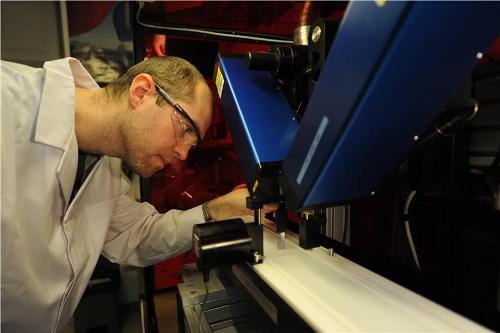Two techniques for fabricating gold monolayers, which are thin films of nanoparticles, have been devised by scientists at the Institute of Physical Chemistry of the Polish Academy (IPC PAS) in Warsaw. One technique is based on self-assembly, whereas the other utilizes the properties of salt solutions that are highly concentrated. Both these techniques assist in developing consistent, positively charged monolayers.
 Dr Volodymyr Sashuk deposits an ordered layer of gold nanoparticles on a glass plate.
Dr Volodymyr Sashuk deposits an ordered layer of gold nanoparticles on a glass plate.
Silicon and glass surfaces may produce a negative electric charge upon contact with water. The technique of depositing uniform and thin layers of gold nanoparticles, which are positively charged, on these surfaces appeared impossible until now. Instead of forming a consistent layer, the nanoparticles separated and created many clusters. Chemists generally include salt to the working solution to minimize the electrostatic interactions between the nanoparticles. The salt anions protected the nanoparticles, which is then able to deposit more tightly.
Katarzyna Winkler, a PhD student at the IPC PAS, observed that higher concentration of salt in the solution tends to destabilize the entire system. Hence, at a particular level of salt concentration, the nanoparticles begin to separate from the solution as aggregates. This occurrence was generally believed to be an impossible task. The researchers then decided to analyze how the nanoparticles will react if the concentration of the salt is increased. It was noted that the working solution recovered its stability, and also the nanoparticles present in the solution do not aggregate but interact with the substrate.
The second technique for developing consistent nanoparticle films on substrates is based on self-assembly. Initially, gold nanoparticles were coated with thiols. During the experiments, both uncharged and electrically charged hydrophobic ones were utilized by researchers. Nanoparticles that were enclosed by the thiols were positioned on a water surface.
Dr. Volodymyr Sashuk from the IPC PAS informed that if the proportions are correctly modified between uncharged and charged thiols, the nanoparticles on the water surface act like floats and create a monolayer without sinking. The nanoparticle layer formed on the water surface through self assembly can be packed mechanically with a Langmuir balance apparatus. This compression allows the nanoparticles to come close to one another to a much shorter distance. The Langmuir–Blodgett method can be used to transfer the monolayer to a glass substrate and enables the formation of hydrophilic or hydrophobic surfaces.
The first technique can also be applied to create layers on semiconductor substrates.